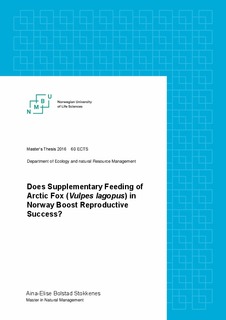| dc.contributor.advisor | Bischof, Richard | |
| dc.contributor.author | Stokkenes, Aina-Elise | |
| dc.date.accessioned | 2016-08-31T12:25:18Z | |
| dc.date.available | 2016-08-31T12:25:18Z | |
| dc.date.issued | 2016-08-31 | |
| dc.identifier.uri | http://hdl.handle.net/11250/2403143 | |
| dc.description.abstract | Ekstra fôring er eitt av fleire bevaringstiltak som har blitt brukt for å auke dyrs levedyktigheit. Supplerande fôring har hatt ulikt resultat basert på dyrs åtferd, intensitet og tilpassing av tiltak. Fjellrev er i Noreg ført opp som kritisk truga i den nasjonale raudlista, og har ein bestand med færre enn 150 vaksne individ. Det er sett i gang ulike tiltak for hjelpe bestanden av fjellrev; supplerande fôring med hundefôrpellets, avl og utsetjing av kvalpar, samt raudrevkontroll i einskilde deler av Skandinavia. I løpet av åra som tiltak er gjennomført (2006-d. d) har ein lukkast med å auke fjellrevbestanden. For å tilpasse adaptive tiltak, er det viktig å finne ut om, og eventuelt i kor stor mengde supplerande fôring har påverka fjellrevbestanden. I denne avhandlinga testar eg ei rekkje hypotesar knytt til bruk av fôringsstasjonar av fjellrev og den moglege effekten supplerande fôring kan ha på reproduksjon og kullstorleik. Metoden eg har nytta i oppgåva er analyser av ekskrement frå fjellrev for å kvantifisere samansetjinga av- og bidraget av hundemat i dietten. Ekskrement vart samla inn på kjente hilokalitetar. Eg undersøkte vidare rolla av førekomsten av smågnagarar, klima og tilgjengelegheita av fòringsstasjonar i relasjon til nærleik for eitt gitt i hi i høve hundemat i dietten. Til slutt testa eg samanhengen mellom fekunditet (sannsynet for å reprodusere og kullstorleik) og diettsamansetjinga og klima variablar. Studieperioden inneheldt både år med låg og høg tettleik av smågnagarar. Diettanalysen viste at smågnagarar var hovudbyttet i alle år. Analysane viste at sannsynet for reproduksjon og kullstorleik var positivt påverka av smågnagartettleik. Derimot fant eg ingen bevis for noko effekt av ekstra fôring på reproduksjon, eller kullstorleik. Basert på mine funn i denne oppgåva kan eg ikkje konkludere med at ekstra fôring har ein effekt på reproduksjon, eller kullstorleik hjå fjellrev i Sør-Noreg. Eg tilrår vidare undersøkingar i høve dette emnet. | nb_NO |
| dc.description.abstract | Supplementary feeding is a popular conservation measure, used to help wildlife population gain viability. Supplementary feeding programs can have variable outcomes, due to differences in its implementation and behaviour of the target species. The Arctic fox on mainland Norway is designated as critically endangered on the national red list; with a population of less than 150 reproductive individuals. Major conservation actions are used to help the arctic fox population gain viability: supplementary feeding with dog food, captive breeding and release of pups, and red fox control in some parts of its Scandinavian range. Since the start of active management of the species in 2006, the Norwegian arctic fox population has increased. Important questions regarding arctic fox management and conservation in Norway concerns the impact of supplementary feeding. In this thesis I tested a series of hypotheses related to the use of supplementary food by arctic foxes and the potential effect supplementary feeding may have on reproduction and litter size.
Using arctic fox faeces collected at known active den sites, I quantified diet composition, and assessed the contribution of supplementary food (dog food) in the diet. I then explored the role of annual rodent abundance, climatic conditions, and the availability of feeding stations in the vicinity of a given den on the proportion of supplementary food in the diet. Finally, I tested for relationships between fecundity (probability of reproducing and litter size) and diet composition, environmental covariates. The study period spanned through portion of the rodent cycle and included years with both low and high rodent abundances. The diet analysis revealed that rodent was the main prey in all years. The result revealed that both the probability of reproduction and litter size are positively affected by rodent index. However, I detected no evidence of any effect of supplementary feeding on reproduction or litter size. Based on findings in this thesis I cannot conclude that supplementary feeding had an effect on arctic fox reproduction or litter size, and I will recommend future research on this topic. | nb_NO |
| dc.language.iso | eng | nb_NO |
| dc.publisher | Norwegian University of Life Sciences, Ås | |
| dc.subject | Arctic fox-Supplementary feeding-Rodent abundance-Reproduction-Litter size | nb_NO |
| dc.title | Does supplementary feeding of arctic fox (Vulpes lagopus) in Norway boost reproductive success? | nb_NO |
| dc.title.alternative | Har supplerande foring av fjellrev i Norge ført til auka reproduksjon? | nb_NO |
| dc.type | Master thesis | nb_NO |
| dc.source.pagenumber | 34 | nb_NO |
| dc.description.localcode | M-NF | nb_NO |
